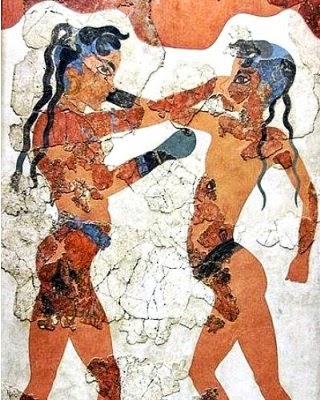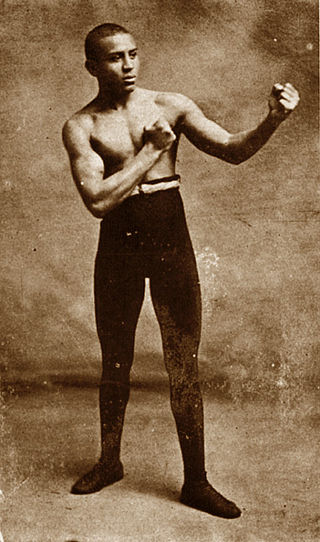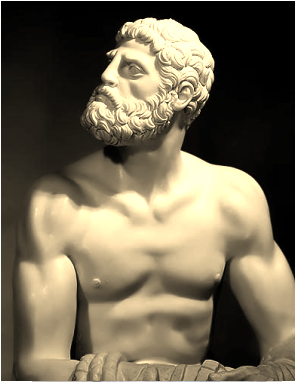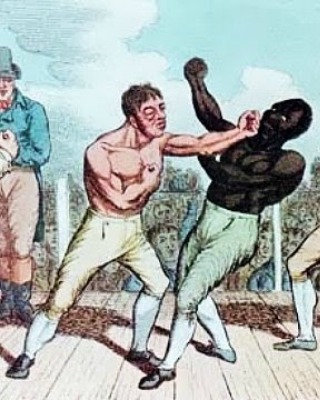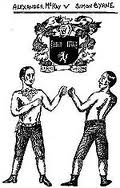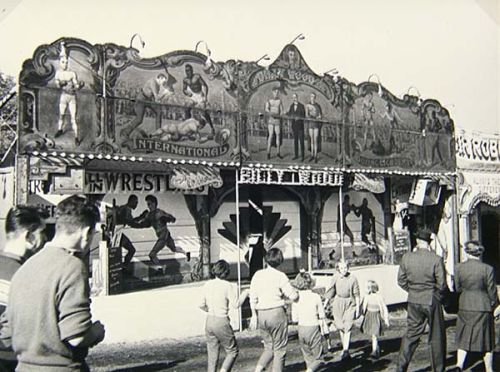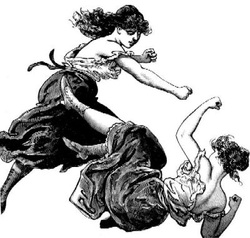* Simon Byrne billed as "Champion of Ireland", fought Alexander McKay, the "Champion of Scotland", for the right to challenge Jem Ward, the heavyweight champion of England.
The injuries McKay received in his fight with Byrne resulted in his death the following day, and rioting in his home country of Scotland.
Byrne went on to lose his next match against Jem Ward, which some commentators believed he was not sufficiently in condition to fight.
His final contest in May 1833 was a gruelling 99 rounds against James Burke that lasted for 3 hours and 6 minutes, the longest ever recorded prize fight.
Byrne died three days later as the result of damage to his brain caused by the beating he had received
The Times of 5 June 1830 condemned the "barbarous, filthy and swindling exhibitions called prize fights" and expressed the hope that "an example will be made of the more wealthy monsters in this affair of blood – the sanguinary cowards who stood by and saw a fellow creature beaten to death for their sport and gain!"
Bare-knucle fighters were stripped to the waist , but did not wear gloves. Kicking , biting and gouging were not allowed , and neither was hitting or grabbing below the waist. But most other thing were. Wrestling was an essential part. The opponent could be knocked or thrown to the ground, either by picking him up around the waist or by a popular move known as cross buttock. Having thrown an opponent to the floor it was allowed to fall on top of him as heavily as possible.
It was not allowed to strike a man or inflict damage once he was down apart from falling on him. A round ended when a man was down, and there was a 30 second break before the next. Rounds could therefore be of any length and carried on until one man was unable to continue. There were no refs as the spectators were the guardians of fair play.
Travelling fairs might have a boxing booth, in which professionals would challenge the public or box each other, with spectators paying to watch.
The fairground boxing booth, for over two hundred years, was a cradle for many of the great British boxing hopes. During its illustrious history fighters such as Jem Mace, Kid Furness, Jimmy Wilde and Tommy Farr all fought, exhibited on or ran boxing shows.
A man who showed strength and aptitude would become a champion of his village or locality, and his neighbours would support him in challenges to other local champions. A “purse “ might be put up for the winner and there would be plenty of betting.
In their heyday each region of the country would have three or four main booths travelling the fairground circuit with the boxers fighting for Championships at both a regional and national level. The fairground boxing booth with its brightly coloured frontage displaying the names and faces of boxing's heritage is now a fading memory on the fair and has gone the way of other side-shows.
After the introduction of the Marquis of Queensberry rules in 1867, the sport gradually changed and eventually ended the old days of pugilism.
The showman who bridged the gap between the bareknuckle days and the introduction of the Queensberry rules was Jem Mace a man who many boxing historians see as the pioneer of the modern travelling boxing booth with its exhibitions fights, stage show and the introduction of inviting all challengers into the ring.
Jem Mace worked as both a showman promoter and pugilist and became the bridge between the old style boxing arenas and boxing as part of the entertainment route. During his colourful and often controversial career, from 1858 onwards Jem fought for many unofficial title and championship battles and despite "retiring" in 1867 he still travelled to America in the 1870s and beat Tom Allen for the Championship of the World.
The ringing chorus that used to accompany Jem Mace as he took the stage:
Good old Jimmy, Brave old James,
Take a list and run all down the pugilistic names,
Search through Fistiana and see if you can trace
A man with such a record as old Jem Mace.
Jack Broughton well deserves his title, Father of the English School of Pugilism. He drew up the first definite code of rules for the growing sport, and they were the final authority for almost 100 years. It was he who introduced boxing gloves, or mufflers, as they were called, in the interest of the noblemen and gentlemen who were his patrons and pupils. The new invention caught on at once for sparring, but the serious business of fighting in the ring continued to be a bareknuckle matter until the day, far in the future, of John L. Sullivan.
A bare-knuckle round according to Broughton's rules lasted until a man went down, and he could be thrown as well as knocked down, provided he was held above the middle. Half a minute was allowed between rounds, which could last anywhere from a few seconds to as much as half an hour.
Broughton's tenure as champion was a good time for boxing. In 1750, however, he made the mistake of fighting a grudge fight with a younger man named Jack Slack. The men met at Broughton's Amphitheatre, with the odds 10 to 1 on the champion. . The fight lasted only 14 minutes. A blow between the eyes blinded Broughton, and Slack had only to continue hitting him until he was unable to rise again.
Broughton never again raised his fists for money, except to instruct the young and hopeful with the mufflers. He is buried in Westminster Abbey, the only boxer to be so honored.
The ring reeled after his defeat, and went on reeling and staggering for three decades. For a time there could be no fights in London, even illegally. In the provinces there were magistrates who would wink a friendly eye if a match was arranged, or who could be outwitted.
It wasn't only men who fought for money In Georgian London, the ladies liked a shot at the title too. Of course, women have fought in staged competitions since ancient times, but lady bare-knuckle fighters became very popular in London in the early 18thC.
Bare-Knuckle Boxing Links:
http://www.boxingtreasures.com/jembuvsnedne.html
http://www.historyoffighting.com/bare-knuckle-boxing-champions.php
http://historyofbkb.weebly.com/bkb-figureheads.html
https://www.facebook.com/pages/History-of-Bareknuckle-Boxing/147078882103479
http://www.boxingtreasures.com/boxinglinks.html
http://www.historyoffighting.com/boxing-in-the-ancient-world.php


